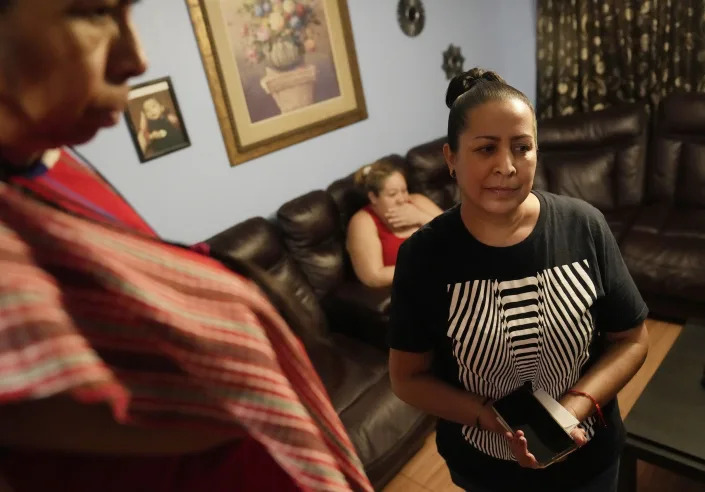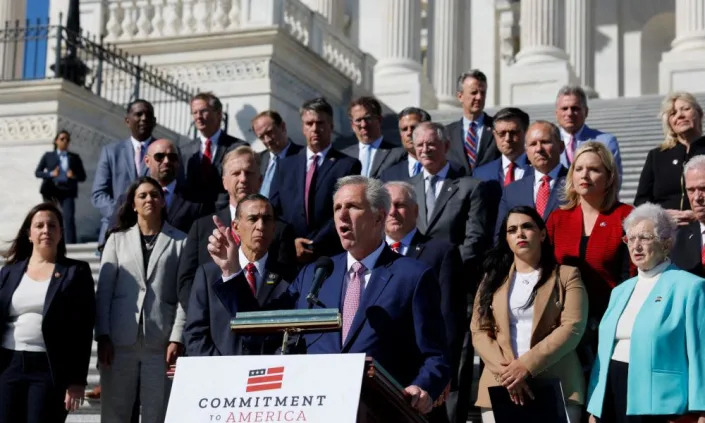USA Today
Climate change is on the ballot in the midterm elections: Here’s what’s at stake.
Elizabeth Weise – October 22, 2022

With half of registered voters saying climate change is one of the most important issues in the upcoming midterm elections, could the results on Nov. 8 mean changes for U.S. policy regarding global warming?
A significant shift in the makeup of Congress would mostly involve delays rather than major legislation being rescinded. But time is of the essence as scientists continue to warn that without immediate and deep emission reductions across all sectors, limiting global warming to 1.5 degrees Celsius will soon be “beyond reach.”
Democrats have set up several major climate change initiatives at the national level that Republicans would like to roll back. To do so, they will need a landslide victory — and even then hitting the undo button will be a challenge.
Five major climate initiatives are at stake as voters decide who controls the House and Senate, along with governor’s races and ballot initiatives across the nation.
Related video: Biden says he’ll use executive powers to fight climate change
Ad: 0:18 0:30 https://s.yimg.com/rx/martini/builds/51382509/executor.html Scroll back up to restore default view.
Scroll back up to restore default view.
Here’s a look at what the midterms mean for the climate:
‘Undo’ of Inflation Reduction Act still possible
Coming just 85 days after the most consequential piece of climate legislation ever passed in the United States, the outcome of the midterm elections are unlikely to erase key provisions of the Inflation Reduction Act unless Republicans gain a two-thirds majority in both the House and Senate.
INFLATION REDUCTION ACT: Answering your common questions about the legislation
INFRASTRUCTURE ACT: The massive 2021 infrastructure act aimed to fight climate change. Is it living up to Biden’s pledge?
The sweeping legislation includes record spending on clean energy initiatives. It also has measures to reduce prescription drug prices and to ensure large corporations pay income taxes.
The law was approved by the Senate on Aug. 7 in a party-line vote. To dismantle it would require passage of a new law to either repeal or replace it, a virtually impossible task given current political realities.
To overcome a veto by President Joe Biden, Republicans would have to gain a two-thirds majority in both houses of Congress, which is seen as unlikely.
The other truth in politics is that once a major bill such as the IRA is passed, the longer it is in effect, the less likely it is to be overturned.
“It’s hard to do big things and it’s hard to undo big things,” said Tiernan Sittenfeld, senior vice president for governmental affairs with the League of Conservation Voters.
‘Shouting distance’: That’s how close the Inflation Reduction Act would get US to its climate goals
Critical water rights decisions hang in the balance amid megadrought
Two governors’ races could affect the 40 million Americans who get their water under the century-old Colorado River compact.
A megadrought that’s lasted for 22 years has pushed the mighty Colorado River well beyond its limits. Scientists estimate about 40% of the drought is attributable to human-caused climate trends.
To deal with the extreme lack of water, the Department of the Interior took an unprecedented step earlier this year, demanding governors of the seven states that get water from the river come up with an emergency plan to drastically reduce use.
Interior was clear: If the governors of Wyoming, Colorado, Nevada, New Mexico, Utah, Arizona, and California didn’t come up with a proposal, the agency’s Bureau of Reclamation would do it for them.
WATCH: Low water levels on Mississippi River reveal early 20th century shipwreck in Louisiana
VIDEO: Climate change made drought 20 times more likely
There’s been no deal and things are now on hold as all of the states but Utah have governors’ races on November 8.
How things play out in two of those states, Arizona and Nevada, could delay a state-run plan, causing the Department of the Interior to step in.
In both states, Republicans with unorthodox water plans are polling well and could end up calling the shots.
In Arizona, Republican candidate Kari Lake wants to prioritize finding additional water supplies rather than conservation. Her major proposals to deal with the state’s water shortages are building a pipeline to bring water from the Missouri and Mississippi rivers or constructing seawater desalination plants.
But desalinization would raise costs significantly and a pipeline is likely politically unworkable.
Conservation is really the only option, said Eric Kuhn, former general manager of the Colorado River District.
“The water’s just not there,” he said.
In Nevada, Republican candidate and political firebrand Joe Lombardo says California gets too much water under current rules and the entire Colorado River Compact should be renegotiated.
WATCH: Mississippi River’s low water level reveals shipwreck
VIDEO: Millions of Americans still drink unsafe tap water. Here’s why.
That seems unlikely to happen. The Compact was ratified in 1922. To create a new one would require the approval of Congress, state legislatures and governors.
Whatever humans do, in the end Mother Nature calls the shots, said Kuhn, the co-author of “Science Be Dammed: How Ignoring Inconvenient Science Drained the Colorado River.”
“You can’t deliver more water than you have.”
Plan to make companies disclose climate data not finalized
In the financial world, a historic climate change rule that could significantly change what investors are told about companies’ risk is set to be finalized next year. A shift in the composition of Congress could throw up roadblocks, though might not derail it.
The Securities and Exchange Commission proposed the rule in March. It would require public companies to disclose the risks they face from global warming as well as disclosing their greenhouse gas emissions. The rule doesn’t require companies to change what they’re doing, only to make it known to potential investors.
Already at least 16 Republican state attorneys general have contested the proposed rule and it’s anticipated that multiple lawsuits will be brought against it.
Others believe it will survive opposition.
“This rule was built to survive legal challenges,” said Elizabeth Small, head of policy for CDP, a nonprofit that runs a voluntary climate disclosure system for companies.
Two states propose landmark climate initiatives
While several states and numerous counties and cities have various climate initiatives, two stand out because of the size and economic importance of the states contemplating them.
In California, Proposition 30 would increase by 1.75% the tax on people who make more than $2 million. The resulting money – as much as $5 billion per year by state estimates – would go toward building electric and hydrogen vehicle charging stations and wildfire suppression and prevention programs.
If California were a country, it would have the world’s fifth-largest economy, so what the state does matters. If it passes, the initiative could spur the adoption of zero-carbon vehicles and construction of infrastructure to support them, both electric and hydrogen, not just in California but across the United States.
Across the country in New York state, Proposal 1 would allow the state to issue $4.2 billion in bonds for environmental, natural resources, water infrastructure, and climate change mitigation projects.
The Clean Water, Clean Air, and Green Jobs Environmental Bond Act would pay for environmental improvements across the state, including $1.5 billion for climate change mitigation, $1.1 billion to restoration and flood risk reduction, $650 million to conserve open spaces and $650 million for water quality in resiliency infrastructure.
If the historically large measure results in the jobs and cleaner, healthier environment supporters say it will, it could encourage other states to take similar steps.
Agriculture at the center of another, bigger fight ahead
How these climate issues play out could set the stage for an even bigger fight expected to begin in earnest after the midterms.
Every five years since 1933, Congress passes a piece of legislation that touches almost every aspect of America’s agriculture and nutrition policy: the farm bill. Formally known as the Agriculture Improvement Act, in 2018 it cost $428 billion and is an enormous driver of what American grows and eats.
Agriculture accounts for 11% of total U.S. greenhouse gas emissions, according to the Environmental Protection Agency. Conservation and sustainability are expected to be big issues as the details of the next farm bill are hashed out.
“It could be a huge opportunity for advancing climate solutions,” said Sittenfeld. “There’s no overstating the potential for the farm bill as we have very ambitious goals for cutting climate emissions.”









